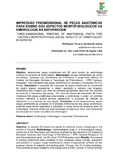| dc.relation | AUSTINO, J. INSTITUTO FEDERAL DE EDUCAÇÃO, CIÊNCIA E TECNOLÓGICA
DE SANTA CATARINA -CAMPUS FLORIANÓPOLIS DEPARTAMENTO
ACADÊMICO DE SAÚDE E SERVIÇOS CURSO SUPERIOR DE TECNOLOGIA EM
RADIOLOGIA DESENVOLVIMENTO DE MODELO DE MANDÍBULA EM
IMPRESSÃO 3D PARA FINS DIDÁTICOS. [s.l: s.n.]. Disponível em:
<https://repositorio.ifsc.edu.br/bitstream/handle/123456789/2298/TCC_Juliana_e_Sc
arlet_2021.pdf?sequence=1>. Acesso em: 2 nov. 2022.
AIMAR, A.; PALERMO, A.; INNOCENTI, B. The Role of 3D Printing in Medical
Applications: A State of the Art. Journal of Healthcare Engineering, v. 2019, p. 1–10,
21 mar. 2019.. Disponível em: https://pubmed.ncbi.nlm.nih.gov/31019667/. Acesso
em: 11 de Nov, 2022.
BARRETO, T. F. Uso de peças anatômicas em 3D como estratégia para o ensino da
anatonomia em curso médico. Bahiana.edu.br, 2017. Disponível em:
https://repositorio.bahiana.edu.br:8443/jspui/handle/bahiana/2201. Acesso em: 11 de
Nov, 2022.
BIGLINO, G. et al. Use of 3D models of congenital heart disease as an education
tool for cardiac nurses. Congenital Heart Disease, v. 12, n. 1, p. 113–118, 26 set.
2016. Disponível em: https://pubmed.ncbi.nlm.nih.gov/27666734/. Acesso em: 28 de
Out, 2022.
COLARES, K. T. P.; OLIVEIRA, W. D. Metodologias Ativas na formação profissional
em saúde: uma revisão. Revista Sustinere, v. 6, n. 2, p. 300–320, 10 jan. 2019.
Disponível em: https://www.e-
publicacoes.uerj.br/index.php/sustinere/article/view/36910/27609. Acesso em: 22 de
Out, 2022.
FIGUEIRED, B; IGNÁCIO GIOCONDO CESAR, F. UM ESTUDO DA UTILIZAÇAO
DA IMPRESSORA 3D NA ENGENHARIA E NA MEDICINA. RECISATEC - REVISTA
CIENTÍFICA SAÚDE E TECNOLOGIA - ISSN 2763-8405, v. 2, n. 1, p. e2170, 23 jan.
2022. Disponível em: https://recisatec.com.br/index.php/recisatec/article/view/70.
Acesso em 26 de Out, 2022.
HENRIQUE, L. INSTITUTO FEDERAL DE EDUCAÇÃO, CIÊNCIA E TECNOLOGIA
DE SANTA CATARINA CÂMPUS FLORIANÓPOLIS DEPARTAMENTO
ACADÊMICO DE SAÚDE E SERVIÇOS CURSO SUPERIOR DE TECNOLOGIA EM
RADIOLOGIA. [s.l: s.n.]. Disponível em:
<https://repositorio.ifsc.edu.br/bitstream/handle/123456789/419/TCC%20Larissa%20
Henrique%20Final.pdf?sequence=1&isAllowed=y>. Acesso em: 2 nov. 2022.
HORONATO, C.A; DIAS, K.K; DIAS, K.C.B. APRENDIZAGEM SIGNIFICATIVA:
Uma Introdução à Teoria SIGNIFICANT LEARNING: An Introduction to Theory. V.3
n.1, Goiás, 2018.
JOGO, D. UNIVERSIDADE DO ESTADO DO RIO GRANDE DO NORTE
FACULDADE DE CIÊNCIAS EXATAS E NATURAIS PROGRAMA DE PÓS-
GRADUAÇÃO MESTRADO PROFISSIONAL EM ENSINO DE BIOLOGIA USO
COMBINADO DE METODOLOGIAS NO ENSINO-APRENDIZAGEM DE
EMBRIOLOGIA HUMANA: ANIMAÇÃO GRÁFICA E CONSTRUÇÃO. [s.l: s.n.].
Disponível em: <https://www.profbio.ufmg.br/wp-content/uploads/2021/10/TCM-
POLYANNE-RIBEIRO-DE-MACEDO-VERSAO-FINAL.pdf>.
LOKE, Y.-H. et al. Usage of 3D models of tetralogy of Fallot for medical education:
impact on learning congenital heart disease. BMC Medical Education, v. 17, n. 1, 11
mar. 2017. Disponível em:
https://pubmed.ncbi.nlm.nih.gov/28284205/#:~:text=Three%2Ddimensional%20(3D)
%20models,Fallot%20following%20a%20teaching%20session.. Acesso em: 29 de
Out, 2022.
MACEDO, D.D.J; MARTINS P.R; TOURINHO F.S.V. A evolução no desenvolvimento
de tecnologias e a saúde 4.0: disrupção do novo. v.1, 2022. Disponível em:
https://www.editoracientifica.com.br/artigos/a-evolucao-no-desenvolvimento-de-
tecnologias-e-a-saude-40-disrupcao-do-nov o. Acesso em: 29 de Out, 2022
MATOZINHOS, I. P. et al. IMPRESSÃO 3D: INOVAÇÕES NO CAMPO DA
MEDICINA. REVISTA INTERDISCIPLINAR CIÊNCIAS MÉDICAS, v. 1, n. 1, p. 143–
162, 2 fev. 2017. Disponível em:
http://revista.fcmmg.br/ojs/index.php/ricm/article/view/14. Acesso em: 30 de Out,
2022.
MEIRA, M. DOS S. et al. Intervenção com modelos didáticos no processo de ensino-
aprendizagem do desenvolvimento embrionário humano: uma contribuição para a
formação de licenciados em ciências biológicas. Ciência e Natura, v. 37, n. 2, p.
301–311, 2015. Acesso em: https://www.redalyc.org/articulo.oa?id=467546186014.
Acesso em: 30 de Out, 2022.
MOORE K; PERSAUD T.V.N, Torchia MG. Embriología clínica. 10a ed. Elsevier
Brasil, 2016.
MULFORD, J. S.; BABAZADEH, S.; MACKAY, N. Three-dimensional printing in
orthopaedic surgery: review of current and future applications. ANZ Journal of
Surgery, v. 86, n. 9, p. 648–653, 12 abr. 2016. Disponível em:
https://pubmed.ncbi.nlm.nih.gov/27071485/. Acesso em: 30 de Out, 2022.
MUNIZ, A. DE L.; MORAES, S. G. UTILIZAÇÃO DE MODELOS 3D COMO
RECURSO DIDÁTICO NO ENSINO DE EMBRIOLOGIA DO SISTEMA NERVOSO
CENTRAL. CIET:EnPED, 30 maio 2018. Disponível em:
https://cietenped.ufscar.br/submissao/index.php/2018/article/view/783. Acesso em:
30 de Out, 2020.
OLIVEIRA, H.N.P; DIAS, R.N; RODRIGUES, H.G. DESIGN AND MANUFACTURE
OF EMBRYOLOGICAL MODELS FOR DIDACTIC USE. Bioscience Journal, v. 35.
Disponível em: https://seer.ufu.br/index.php/biosciencejournal/article/view/42649.
Acesso em: 08 de Nov, 2022.
ORLANDO, G. S. [UNIFESP. Impressão 3D de imagens de Ressonância Magnética
da pelve feminina para ensino em ginecologia. repositorio.unifesp.br, 2022.
Disponível em: https://repositorio.unifesp.br/handle/11600/63244. Acesso em: 30 de
Out, 2022.
VENTOLA, C. L. Medical Applications for 3D Printing: Current and Projected Uses. P
& T : a peer-reviewed journal for formulary management, v. 39, n. 10, p. 704–11,
2014. Disponível em: https://www.ncbi.nlm.nih.gov/pmc/articles/PMC4189697/.
Acesso em: 03 de Nov, 2022.
WEN, C. L. Homem Virtual (Ser Humano Virtual 3D): A Integração da Computação
Gráfica, Impressão 3D e Realidade Virtual para Aprendizado de Anatomia, Fisiologia
e Fisiopatologia. Revista de Graduação USP, v. 1, n. 1, p. 7, 18 jul. 2016. Disponível em: https://www.revistas.usp.br/gradmais/article/view/117669. Acesso em: 03 de
Nov, 2022.
WERNER JÚNIOR, H. et al. Applicability of three-dimensional imaging techniques in
fetal medicine. Radiologia Brasileira, v. 49, n. 5, p. 281–287, out. 2016. Disponível
em: https://www.researchgate.net/publication/309902010_Applicability_of_three-
dimensional_imaging_techniques_in_fetal_medicine. Acesso em: 03 de Nov, 2022.
YE, Z. et al. The role of 3D printed models in the temaching of human anatomy: a
systematic review and meta-analysis. BMC Medical Education. v. 20, n. 1, 29 set.
2020. Disponível em: https://pubmed.ncbi.nlm.nih.gov/32993608/. Acesso em: 08 de
Nov, 2023. | pt_BR |


